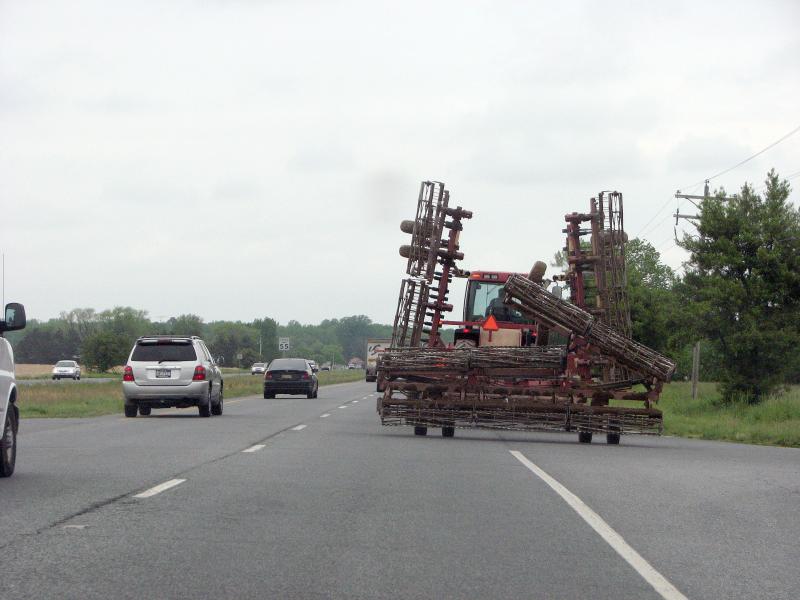Motorists advised to be careful and alert when sharing the road with farm equipment
The Delaware Department of Transportation and the Department of Agriculture are urging motorists to be alert for the presence of farm equipment on roads and to practice safe road-sharing techniques. Harvest season has started, and farmers are moving tractors, trailers, trucks and other large equipment on state roads as they move between fields or to equipment-staging areas.
Farm equipment operators understand that their presence can delay other motorists' trips and will often pull off the roadway at the first available safe location to allow them to pass. Motorists should not assume, however, that the farmer can move aside to let them pass wherever there is an open space. Shoulders may be soft, wet, steep or not able to support the weight, and pulling off the road could cause the farm vehicle to tip.
If motorists encounters a wide vehicle, they should yield. On rural roads, some farm equipment may be wider than the lane of travel. If motorists approach wide farm equipment traveling in the opposite direction on a rural road and they cannot pass safely, they should stop and consider the safest alternative, ither to pull off the road, safely turn around or back up to a location that will allow the equipment to pass.
Motorists should never assume the driver of farm equipment knows they are there. Most operators of farm equipment will regularly check to see if there is traffic behind them. However, the farmer must also look ahead to keep the equipment safely on the road and to watch for oncoming traffic.
Farm equipment is very loud, and the farmer will probably not be able to hear another vehicle. Therefore, motorists should not assume that the farmer knows where their vehicles are located. Before attempting to pass, motorists should be sure they have a clear line of sight down the road ahead and that there is no oncoming traffic. If they are in an area where passing is allowed, motorists should use their car horns to signal to the farmer that they are there and then pass with caution. Motorists should not pass if they are in a designated no passing zone or within 100 feet of any intersection, railroad grade crossing, bridge, elevated structure or tunnel. Also, motorists should be watchful of vehicles behind them that may also try to pass.
Motorists should not assume that a farm vehicle that pulls to the right side of the road is going to turn right or is letting them pass. Due to the size of some equipment, farmers must execute wide left-hand turns. If unsure, motorists should check the operator's hand signals and look to the left side of the road for gates, driveways or any place a farm vehicle might turn.
While driving on rural roads, motorists may encounter farm equipment at any time. Sometimes they will see a single vehicle, such as a tractor or combine. Other times the equipment will consist of a tractor with an implement in tow.
Farm equipment is designed to be used primarily in a field and is not designed to travel at typical highway speeds. Most farm equipment is designed to travel at speeds of 15-25 miles per hour. If a motorist is driving 55 mph and comes upon a tractor that's moving 15 miles per hour, it only takes five seconds to close a gap the length of a football field between the motor vehicle and the tractor.
Just as motorists are entitled to operate their vehicles on public roadways, farmers are legally allowed to operate farm equipment on these same roadways.
Tips for farmers
Farmers have a role in road safety too. Following this safety advice will help:
Place a slow-moving vehicle reflector triangle on any machine that travels the road slower than 25 mph.
Always point the triangle up, keep the emblem clean to maximize reflectivity and replace the emblem when it fades, normally every two to three years.
Mark the edges of tractors and machines with reflective tape and reflectors.
Consider installing retrofit lighting on older machinery to increase visibility.
Turn on lights, but turn off rear spotlights when going onto the road. From a distance they can be mistaken for headlights.
Avoid the highway during rush hours and bad weather. To increase visibility, it is best not to drive before sunrise or after sunset.
Use pilot cars, one in front and one in back, if going a considerable distance. Hang an orange flag out the windows of these pilot vehicles.
Consider installing mirrors on equipment to be more aware of surrounding motorists.























































